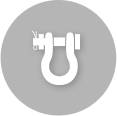Appointed Person - Person In Charge - Lift Director - Verantwoordelijk Persoon
Any type of lifting operation can be hazardous if not performed in accordance with regulations from European and national legislation, such as European Directives and country specific legislation.
Article 3.2.5 of the European Directive 2009/104/EC concerning the minimum safety and health requirements for the use of work equipment reads as follows:
“all lifting operations must be properly planned, appropriately supervised and carried out in such a way as to protect the safety of workers.”
European Directives must be incorporated into the legislation of the individual EU member states. By consequence planning and supervision of lifting operations is an identical legal requirement in all member states of the European Union.
Compare L.O.L.E.R. regulation 8 article 8.1. in the UK; Arbeidsomstandighedenbesluit Article 7.18a paragraph 8 and 9 in the Netherlands; Betriebssicherheitsverordnung Anhang 2 Article 4.2.3 in Germany and Codex boek IV titel 4 Arbeidsmiddelen voor het hijsen of heffen van lasten Art. IV.4-16 in Belgium to name some examples.
In summary: to ensure that all lifting operations conducted in the workplace are safe, the law in all countries of the European Union requires that any lifting operation be planned and overseen by an Appointed Person.
In this guideline, we look into the definition of the Appointed Person for lifting operations, explain what this individual does, his duties and responsibilities, how to become Appointed Person, what training is required and outline some other common roles involved in lifting operations.
Markets
Knowledge
- Appointed Person lifting operations - everything there is to know
- ESTA: Best Practice Guide for Transport and Installation of Onshore WTG Systems
- Guide to the safe use of Overhead Travelling - Gantry - Jib Cranes and Hoists
- Guide for internal heavy transportation in the manufacturing industry
- Crane hardstands for installation of wind turbines by STOWA
- Checklist for safe transport of oversized wind turbine components
- ICSA - Guidance on lifting a load with several mobile cranes - multiple lifting


- Kokermolen 6 - unit 1.07
- 3994 DH Houten (Utrecht)
- The Netherlands

Lifting
Lifting is an activity during which the load is lifted in a controlled and guided manner, normally spoken from the bottom of the load, e.g. by means of a Fork Lift Truck, screw jack, rack jack, hydraulic jack, toe jack, lifting bag, etc.

Rigging
Moving a load horizontally, vertically or at other angles and possibly through different floor levels, by use of different lifting and hoisting equipment. Lifting and hoisting equipment being divided in lifting and hoisting appliances versus lifting and hoisting accessories.

Hoisting
Hoisting is an activity during which the load is suspended and hangs freely, e.g. by means of one or more crane, chain hoist, lever hoist, hoisting portal, beam clamp, winch, floating sheer leg, strand jack hoisting system, etc.

Specialized transport
Transport of heavy, abnormal and oversized objects by means of specialised transport equipment such as Self Propelled Modular Transporters (so-called SPMT), conventional modular and multi axle transporters, skidding techniques, heavy industrial roller sets and heavy duty roller skates based on endless chain techniques.


 +31-(0)30-6342078
+31-(0)30-6342078 info@hadimpro.com
info@hadimpro.com


